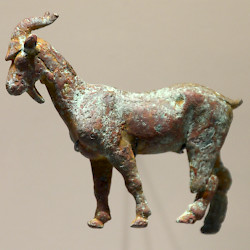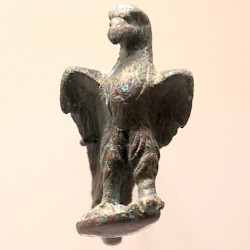Hegra
Q27356Hagra: town in the Al-‘Ula oasis. Originally a town of the Lihyanites, it became part of Nabataea and was reused as a Roman fort. Modern Mada'in Saleh.
Lihyanite Hegra

Hegra (modern Mada'in Saleh or al-Hijr) is the northernmost of the three main towns in the Al-‘Ula oasis, the two other being Dedan (modern Al-Khuraybah) in the center and Quhr (modern Al-Mabiyat) in the south, about forty kilometers beyond Hegra. Although Hegra was, for a long time, not as important as Dedan, foreigners appear to have called the oasis Hegra. For example, the famous statue of the Achaemenid king Darius the Great, made in Egypt and erected in Susa, calls the Arabs hgr.
It was a fertile area, where the water table was less than ten meters underground, allowing for wells to be dug. Some 120 have been identified to the north and east of the town. There must have been extensive palm groves and orchards, while several crops were grown on the fields. There must have been shepherds and merchants, traveling up and down the Incense Route.
Originally, the town was dependent on Dedan, the capital of Lihyan, but coins from the second century BCE with an imitation of Athena suggest that Hegra had managed to obtain some kind of independence. Alternatively, it may just mean that the mint of the kings of Lihyan was in Hegra.
Still, there is something to be said for the independence of Hegra. It may be corroborated by the fact that the town expanded from its original location near a wadi in the west and extended a bit more to the east. The larger town was surrounded by a wall made of mud bricks, with some elements made of sandstone. A wall is usually a sign of autonomy.
In the center of the town was a proud temple, a sacred enclosure dedicated to the “god in the sky”. We can imagine stelas for other deities like the goddess al-‘Uzza (“the strong one”) and Dhu Shara (“lord of Shara”), who are known from inscriptions in the neighborhood.
Nabataean Hegra

At some point in the mid-first century BCE, the Al-‘Ula oasis was taken over by the Nabataeans, traders in incense and myrrh, who had been living in their capital Petra (500 kilometers to the north) for well over two centuries. This was the end of the Lihyanite kingdom and the beginning of an age of great prosperity for Hegra, documented by inscriptions from the reigns of the Nabataean king Aretas IV (9 BCE - 40 CE), king Malichus II (40-70/71), and king Rabbel II the Savior (71-106).
No less than ninety-four monumental rock tombs, comparable to those in Petra, have been identified. The largest of these can be more than twenty-two meters high, while even the smallest tombs have façades with a height of some three meters. Unlike the monuments in Petra, the ones in Hegra often have inscriptions mentioning the names of the dead. Most of these texts are written in Nabataean, some in Aramaic. There are also baetyls and rooms for worship.
 Hegra, Temple, Dedanite inscription |
 Hegra, Temple, Dedanite inscription |
 Hegra, Temple, Lintel with Dedanite inscription |
 Mada'in Saleh, Head of a man |
Roman Hegra

The Roman emperor Trajan (r.98-117) annexed the Nabataean kingdom in 106 CE and the Al-‘Ula oasis became part of the Roman province known as Arabia. Greek and Latin graffiti document the presence of legionaries from III Cyrenaica and a unit of Gaetulian dromedary cavalry. The soldiers in this desert outpost appear to have venerated the Libyan deity Ammon.
The Roman age, however, was not a prosperous one for Hegra. The town was in decline. We do not know why, although the fact that incense was by now traded by boat must have been a contributing factor.
The Roman fort, in the southern part of what had once been a greater settlement, did have a rampart and baths, and a monumental gate was built somewhere between 170 and 220, but the civil settlement was comparatively poor. There was no theater and no monumental forum. The fact that a graffito mentions a local official with the distinctively un-Roman name Amr son of Hayyan suggests that there was no incentive for romanization.
Although the military settlement was rebuilt in the third century, it may have been handed over to a local garrison. In any case, it was abandoned shortly after the mid-fourth century. The civil town was still in use in the fifth century, but was a poor, impoverished settlement.
 Hegra, Necklace |
 Hegra, Oil lamp with an erotic scene |
 Hegra, Pyxis |
 Hegra, Figurine of a goat |
 Hegra, Figurine of an eagle |
 Mada'in Saleh, Sundial |
 Hegra, Byzantine oil lamp |
 Hegra, Decoration of a tomb |
Jewish Al-‘Ula

The Jewish historian Flavius Josephus mentions the Arabian Peninsula as part of the wider Jewish worldnote and it is possible that survivors of the lost war against Rome (66-70 CE) have left the Roman Empire to settle in the towns of the Al-‘Ula oasis. It is certain that in the sixth century CE, there were Jews living in Himyar (Arabia Felix) and the prophet Muhammad encountered Jewish tribes in Yathrib (modern Medina).
Since there were Jews living beyond Al-‘Ula, it is a priori likely that there have been Jews in the oasis as well. Indeed, Jewish proper names have been documented from the early third century CE on in Qurh (modern Al-Mabiyat), the southernmost town of Al-‘Ula and the main settlement in the Islamic age.